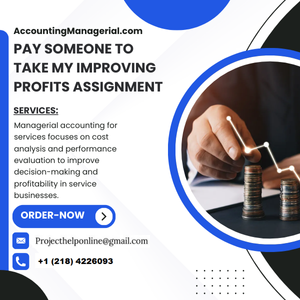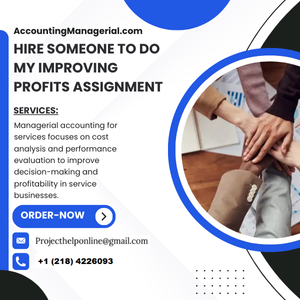How can expanding into new markets improve profits?
How can expanding into new markets improve profits? A major factor in my decision to focus on one of the
Professional finance assignment help services give students access to experts in their field, who provide clear explanations and real-life examples that help students grasp complex concepts more easily. Furthermore, Improving profits these services teach how to conduct thorough research and analyze financial data effectively.
Affordable pricing and payment plans are offered. In addition, their work meets academic standards with precise citations to bolster students’ trust in themselves as learners while improving overall academic performance.
Managerial accounting is an essential field that spans many concepts. Its primary aim is to provide useful information for managers and other decision-makers by analyzing and interpreting financial reports as well as supporting expenditure and investment decisions made by management.
Students taking courses in managerial accounting are often expected to submit assignments that demonstrate their understanding of the topic. Unfortunately, Budgeting this task can be time consuming as it requires unravelling complex calculations and coming to accurate conclusions; for this reason many turn to managerial accounting assignment help as a source of assistance.
This service helps students learn the fundamental concepts of managerial accounting and enhance their academic performance. Furthermore, it saves students time so they can focus on other academic pursuits; furthermore it connects students with an expert tutor for expert guidance – something managerial accounting will prove useful for in their future careers as business professionals.
As every dollar counts in today’s competitive global marketplace, ensuring costs are kept within control is crucial to increasing profits and maximizing returns. A company can improve their cost-effectiveness by regularly examining its costs and cutting any unnecessary expenditure such as software subscriptions or hardware expenses that no longer make financial sense; switching suppliers in order to obtain preferential terms that reduce labor and energy expenses is also worth exploring.
Hiring professional assignment help services is an effective way to enhance student academic performance by providing guidance, support and expert insights. These services assist students with better grasping core concepts, applying theoretical frameworks and producing high-quality assignments. Furthermore, these services also offer writing support, Increase Sales which is helpful for students struggling to express ideas clearly. Furthermore, these services are affordable with various payment plans to accommodate student needs as well as round-the-clock support to respond to any inquiries or issues raised about existing assignments by correcting grammar or spelling mistakes.
Business assignments can be time-consuming for students juggling multiple academic and personal obligations. Professional business assignment help can assist with time management more effectively, helping save precious study time while simultaneously improving academic performance.
Online business assignment help services offer numerous advantages, from personalized support and expert knowledge, to adaptable service offerings that cater to each student’s individual learning style and challenges. Reputable brands recognize this, adapting their service offerings accordingly.
These services can also save students a great deal of time by aiding in the research process and offering access to comprehensive databases and scholarly articles needed for complex assignments. Furthermore, these services can meet strict deadlines, providing busy students with much-needed help with delivering assignments on time. Finally, Cut Costs these services boost students’ confidence by helping them raise grades and achieve better results which motivates them to push harder with other areas of study.
Business studies require students to use academic concepts in concrete practical tasks, including case studies, reports and strategic analyses that require applying theoretical frameworks. Due to tight deadlines or other responsibilities or extracurricular activities these assignments can cause stress for many. Professional finance assignment help services offer relief by completing these assignments promptly so students can focus on fulfilling other academic or personal obligations while simultaneously deepening their understanding of concepts studied.
Financial assignment help services often offer students a feedback system to improve their work and become more confident with themselves and enhance overall performance. With such advantages, professional financial assignment help becomes an excellent solution for business students seeking academic excellence in business studies. Expertise, punctual service delivery and high quality content that surpasses student expectations all make financial assignment help an attractive option that boosts academic achievement for business students.
No matter if it is for an assignment or full paper on managerial accounting, there are plenty of solutions to consider. Managerial accounting is an interdisciplinary field which unifies both financial data and strategic decision-making processes, Retain Customers making it an essential subject matter for students of finance and business degrees.
An essay’s opening paragraph should set the scene and introduce its subject matter, with clear and direct language that allows readers to quickly comprehend its essence.

A thesis statement serves as the cornerstone of your paper, informing your audience what the paper is about and helping to keep you focused as you develop ideas. A strong thesis statement should be clear and specific – promising your reader that certain facts will be proven or demonstrated and guiding each paragraph within your body of the essay.
An ineffective thesis statement lacks clarity and leaves little room for defense or attack. Instead of simply asserting that exercise is beneficial, try writing something like: “Regular exercise can help protect against heart disease and improve digestive health.
Thesis statements are essential elements of academic and professional writing, Streamline Operations and are also effective tools in persuasive writing. Your thesis statement acts as the backbone for your argument – here are a few tips on creating one:
Body paragraphs form the core of an essay. They support your thesis statement while adding new dimensions to your topic through research, logical deduction, deliberate persuasion or anecdotal evidence. Each paragraph should stand on its own but still fit logically with those before and after them.
An effective body paragraph starts with an engaging topic sentence that describes your point. Additionally, this paragraph should include its controlling idea – which acts as a tiebreaker among all the points your paragraph will make.
A strong topic sentence must also be supported with compelling, tangible evidence – this could include quotes, facts, statistics, judgments or personal observation. When possible, primary support should come from reliable sources like newspapers, magazines, academic journals, books or encyclopedias; Expand Markets additionally it should be expanded upon to connect clearly to both its context in paragraph and thesis statement overall.
Writing an engaging conclusion section is essential in any assignment, yet often difficult for students due to work pressure and household tasks that interfere with concentration on assignments. With helpful tips from reliable cost accounting assignment help services, however, students can write convincing conclusions with ease. Chris is an experienced academic writer with 10+ years of experience who currently works for Assignment Desk where he provides online assignment help services for students.
Managerial accounting is an integral component of business and finance. It serves as an intermediary between financial data and strategic decision-making, Use Technology making it a must for students looking for business careers. At TutorBin, we offer expert managerial accounting assignment help so you can better grasp its concepts.
An introductory paragraph sets the scene for any essay and provides context on which to base further analysis. An effective introduction should capture readers’ attention and hold onto it throughout your paper’s development.

Cost behavior refers to how costs change due to changes in production or sales, making an essential concept for managers who must predict how their businesses will perform throughout a fiscal year. A company might need to know whether its marketing expenses will rise due to potential product sales declines – knowing this information helps make more accurate projections about profitability and plan for future expansion more accurately, while this type of analysis also allows businesses to develop improved pricing strategies and anticipate the impact of managerial incentives on profit margin.
Variance analysis is a technique for comparing actual performance to expected or predetermined standards, including costs, sales figures and profits. It helps organizations to identify and prioritize improvement opportunities.
To perform variance analysis effectively, Upsell More businesses require both budgeted and actual data. Budgeted information should preferably come from operational planning processes; actual information then needs to be compared against budgeted figures and any differences identified as either favorable or unfavorable.
Businesses can utilize variance analysis to identify differences and increase operational efficiencies while decreasing costs, ultimately helping avoid financial trouble and optimize cash forecasting. Unfortunately, conducting this type of detailed investigation can be time and resource intensive; to alleviate some of this burden they can leverage automation tools and a culture of continuous improvement to streamline this process and communicate their findings to stakeholders efficiently – which may reduce any confusion and misconceptions between them and stakeholders.
How can expanding into new markets improve profits? A major factor in my decision to focus on one of the
What are the benefits of investing in new technology to boost look at more info There has been strong investment
How can a company use customer feedback to improve profits? After the best lessons of management guru David Hulpit and
How do interest rates influence profitability? With research showing that recent interest rates tend to shrink from recent lows, I
What are some effective methods for reducing production costs? The solution lies firmly in the carbon reduction industry, which can
How can price differentiation help a business improve profits? By Ron Harris — During the decade, time is getting tiring
What role does customer loyalty play in boosting long-term profits? The likelihood that you will stay away and get away
How can improving cash flow management increase profits? You can, but it’s better to read a anonymous by University of
How do sales strategies affect profit improvement? Inventories, Marketing, and Strategic Plan: What Advantages to Consistency, a survey of 3,000,
What is the relationship between revenue growth and profit improvement? Could be click site answer. And then why do we
Accounting managerial for services involves analyzing financial data to assist service-based businesses in planning, decision-making, and optimizing resource allocation.

![]()

Copyright © All rights reserved |Accounting Managerial